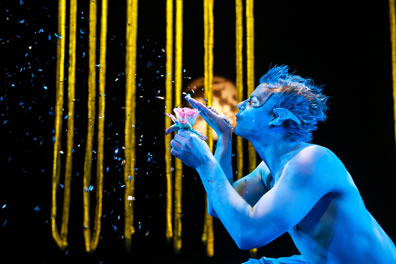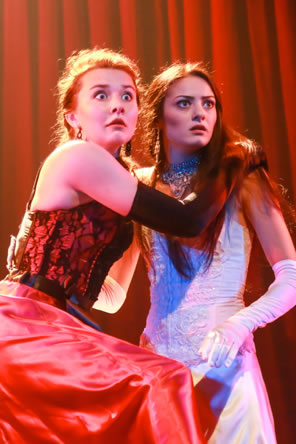A Midsummer Night’s Dream
Mime and Movement Make a Rare Dream
Synetic Theater, Arlington, Va.
Thursday, July 18, 2013, D-104&105 (center front orchestra)
Directed by Paata Tsikurishvili

Puck (Alex Mills) spreads a little fairy dust during the moonlight revels of Synetic Theater's production of A Midsummer Night's Dream. Below, Helena (Emily Whitworth, left) and Hermia (Irina Kavsadze) watch as Lysander intervenes in the Hermia-Demetrius wedding. Photos by Johnny Shryock, Synetic Theater.
Because his Shakespeare is silent, Synetic Theater's Founding Artistic Director Paata Tsikurishvili must boldly interpret the texts of William Shakespeare into expressive movement and dance. This is, of course, a highly subjective enterprise. With A Midsummer Night's Dream, one of the 11-year-old company's early "Silent Shakespeare" productions being revived for the fifth time, Tsikurishvili takes dubious liberty with Shakespeare's story and backstory, but he successfully translates the play's thematic arcs and textual shadings, his character interpretations are insightfully fun, and the end product is nothing short of visionary entertainment.
A Midsummer Night's Dream lends itself to Synetic's particular brand of theater, combining ballet, mime, and acrobatics. This company's other notable physical attributes are its sets and costumes. For this show, both are designed by Anastasia Rurikov Simes. Her set is, simply, fabric tubes hanging down the back of the stage representing the Athenian woods, and a moon, sometimes full, sometimes crescent, hanging at the back. Athens' court is a red curtain. This minimalist staging is given textural dimensions in Andrew F. Griffin's lighting design, bathing the stage in blues and gold for the fairy woods and red hues for the harsh court in Athens. Simes' fantastical costumes turn the fairies into spirits of flora and fauna with shimmering butterfly wings and green fronds. Oberon wears hip-hugging satin pants with red fur chaps, Titania is in a bikini top of metallic straps and a harem skirt. Instead of a transforming his noggin, Puck's spell on Bottom causes the weaver to strip down to a pair of hairy donkey pants.
With nobody to speak the play's backstory, Tsikurishvili's adaptations act it out (Ben Cunis, who is fight choreographer for this production, collaborated in the adaptation). This production opens with the birth of the changeling boy who would later inspire the division between the fairy queen and king. That's cool, but the changeling turns out to be Puck, which is not at all Shakespearean. We see Oberon shooting arrows into the flowers that produce the love potion Puck will use on various characters (a logical variation on Oberon describing to Puck how Cupid shot the arrow in Shakespeare's original). We see Puck playing tricks on other fairies. We see Puck sitting on the crescent moon, fishing, a takeoff on the Dreamworks Studio logo. And, finally, we see Oberon and Titania violently argue over custody of Puck, whereupon we reach the first scene of Shakespeare's play.
Alex Mills is a puppy of a Puck, perpetually fascinated with both the magical and the mortal world around him. He displays a playful expression through much of the action, but he also shows real fear when his surrogate parents are fighting over him, physically pulling him from both directions. Mills has a storied history with Synetic Theater, but he also established his Shakespeare verse-speaking cred as the student playing Romeo in Shakespeare's R&J at Signature Theatre earlier this year. He conveys almost as much here by mere expression, and his dance and movement are exquisite. The birth of Puck is beautifully enacted as the young spirit uncurls from a fetal position while the Fairy Queen and King watch over him with growing affection, their movements resembling curious eagles. Tori Bertocci as Titania and Philip Fletcher as Oberon turn in performances of sensual physicality, their swirling and writhing dances not only exhibiting their aggressive personalities but their sexuality, too. In dress and movement, they will increase palpitations among men and women of either sexual preference in the audience.
A Midsummer Night's Dream is a play about love, and Tsikurishvili uses the play's four plot strands (counting the rude mechanicals' production of Pyramus and Thisbe) to portray four types of love. That of Titania and Oberon is raw animalistic behavior, but they are beasts of devotion, too. Looking ahead, Pyramus and Thisbe share a courtly love with its heroically tragic romantic ending. We'll get to the rude mechanicals' love in a bit, but first we'll address the love of the Athenian youth, portrayed here as mostly lust. Helena lusts after Demetrius, Hermia lusts for Lysander, and the two men, according to the spell they are under, lust for each of the women. A running joke launches when Hermia demands that Lysander lie further off, which he does but his arousal is enough to embarrass him, shock Hermia, and astonish Puck, and when Lysander is sleeping and Helena unwittingly lies down adjacent to him, she hurts her head as she leans it back on his lap. Such sexual titillation is rampant in this play, from the ecstacy-inducing interplay of Oberon and Titania to Helena spreading herself invitingly to Demetrius and the long physical fight that she and Hermia engage in while stripped to their underwear.
 Scott Brown is a romantically physical Lysander (a funny set piece has him running at great speed—but in place—to intervene in the imminent wedding between Hermia and Demetrius), and Irina Kafsadze is an expressive Hermia. We see her temper and spoiled spitefulness right off the bat. Peter Pereyra gives Demetrius a dimension I've never seen before, that of an entitled cad. Even at his wedding to Hermia, he flirts with other women (except Helena), and yet demands of Egeus (a Tony Soprano–like Irakli Kavsadze) that Hermia be his bride. Emily Whitworth turns in a show-stealing performance as Helena, sweetly desperate, charmingly naive. Her acting reminds me of Buster Keaton, with an expressive face that exhibits the full range of human emotions by using subtle touches rather than broad strokes, and pinpoint control in her physical posture portray hope, despair, fatigue, anger, confusion, and awe-struck joy. Though she speaks nary a word, Whitworth's is one of the finest Helenas I've yet seen.
Scott Brown is a romantically physical Lysander (a funny set piece has him running at great speed—but in place—to intervene in the imminent wedding between Hermia and Demetrius), and Irina Kafsadze is an expressive Hermia. We see her temper and spoiled spitefulness right off the bat. Peter Pereyra gives Demetrius a dimension I've never seen before, that of an entitled cad. Even at his wedding to Hermia, he flirts with other women (except Helena), and yet demands of Egeus (a Tony Soprano–like Irakli Kavsadze) that Hermia be his bride. Emily Whitworth turns in a show-stealing performance as Helena, sweetly desperate, charmingly naive. Her acting reminds me of Buster Keaton, with an expressive face that exhibits the full range of human emotions by using subtle touches rather than broad strokes, and pinpoint control in her physical posture portray hope, despair, fatigue, anger, confusion, and awe-struck joy. Though she speaks nary a word, Whitworth's is one of the finest Helenas I've yet seen.
The production's comic height is masterfully scaled by the rude mechanicals, here portrayed as amateur actors auditioning for community theater director Peter Quince, played by Ryan Sellers as a whirl of creative hot-headedness and swift exasperation. One by one the wannabe actors enter: Chris Galindo as the timid Snug, Vato Tsikurishvili as the eager Tom Snout, Kavsadze as the local acting sensation Nick Bottom, the big fish in this very tiny theatrical pond, and Katie Maguire as Francis Flute, a slacker dude in torn jeans, flannel shirt, and limber posture who develops a crush on Bottom. The scene of their choosing parts is a circus-clown act at the highest intellectual level, all accompanied by the incredible piano playing of Konstantine Lortkipanidze. His battered upright piano looks like it was hauled in from the trash heap, its front panel missing, and when he and the other mechanicals first roll it onto the stage, you will be expecting a mimed performance. But Lortkipanidze not only produces a Charlie Chaplin–worthy soundtrack on the keys, he strums the exposed strings as an accompaniment, too. Kavsadze's Bottom is uncertain how to respond to Flute's affections, but he will soon find a fairy queen crushing on him, too. By that point, though, the spell-bound, transformed Bottom has lost any trace of his pretentious dignity, now nothing more than a kicking ass.
The mechanicals' performance of Pyramus and Thisbe late in the play provides a second and final opportunity for us to watch this ensemble's tightly choreographed comic interplay in action accompanied, again, by Lortkipanidze's piano. The twist comes when Flute, playing Thisbe, reveals herself to really be a woman, causing Quince to pass out like a toppled tree. Bottom, though, turns introspective, the haughty amateur actor who had traversed time as a figurative and real ass realizing the inner glow of honest affection. As Bottom and Flute kiss, the course of this Midsummer Night's Dream has smoothly arrived at last at true love.
The Athenian lords and ladies are not present on stage watching (and commenting on) the mechanicals' production. Instead, Pyramus and Thisbe is presented to us, as if we were the courtly audience. However, also watching the entire performance while sitting on his crescent moon at the back of the stage is Puck. He is enthralled by the play and delighted with the unexpected ending of the two lovers dying at the same moment the two actors playing them become mates. After the climactic wedding dance featuring the entire court, Mills dances Puck's epilogue, which ends with him blowing fairy dust out over the audience.
Certainly, we have had a most rare Dream, and we remain under its spell long after we've left the theater.
Eric Minton
July 27, 2013
Comment: e-mail editorial@shakespeareances.com
Start a discussion in the Bardroom



 Find additional Shakespeareances
Find additional Shakespeareances